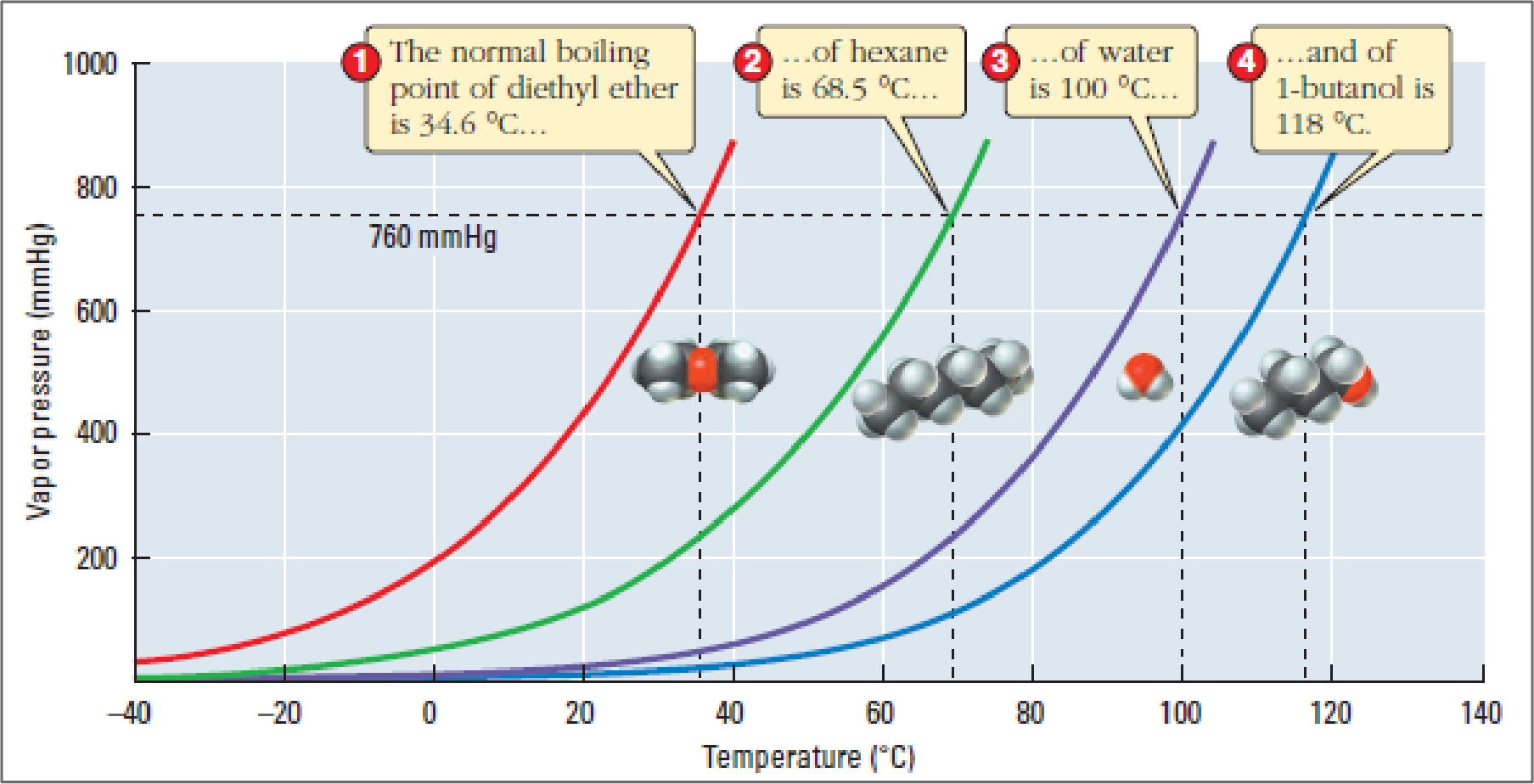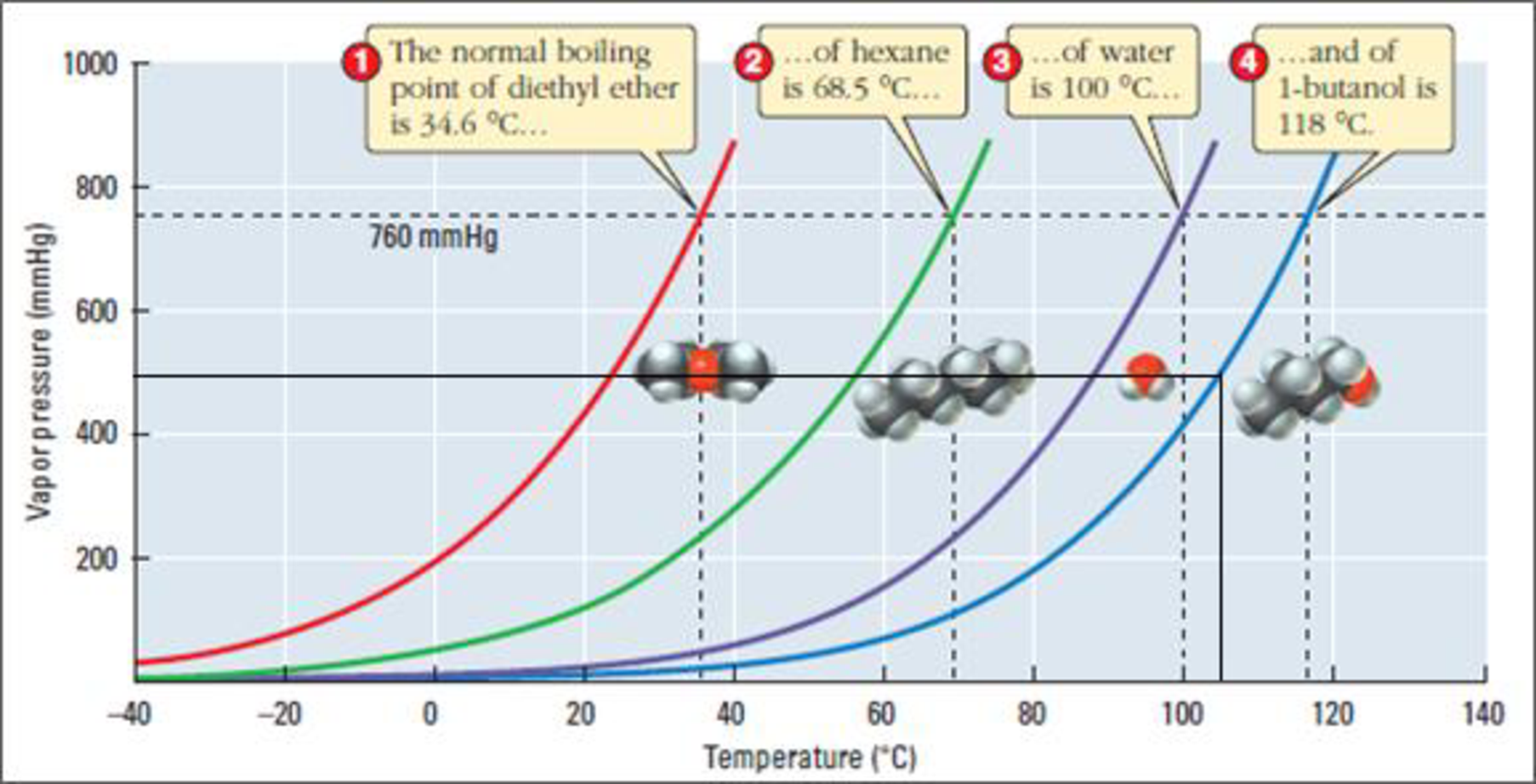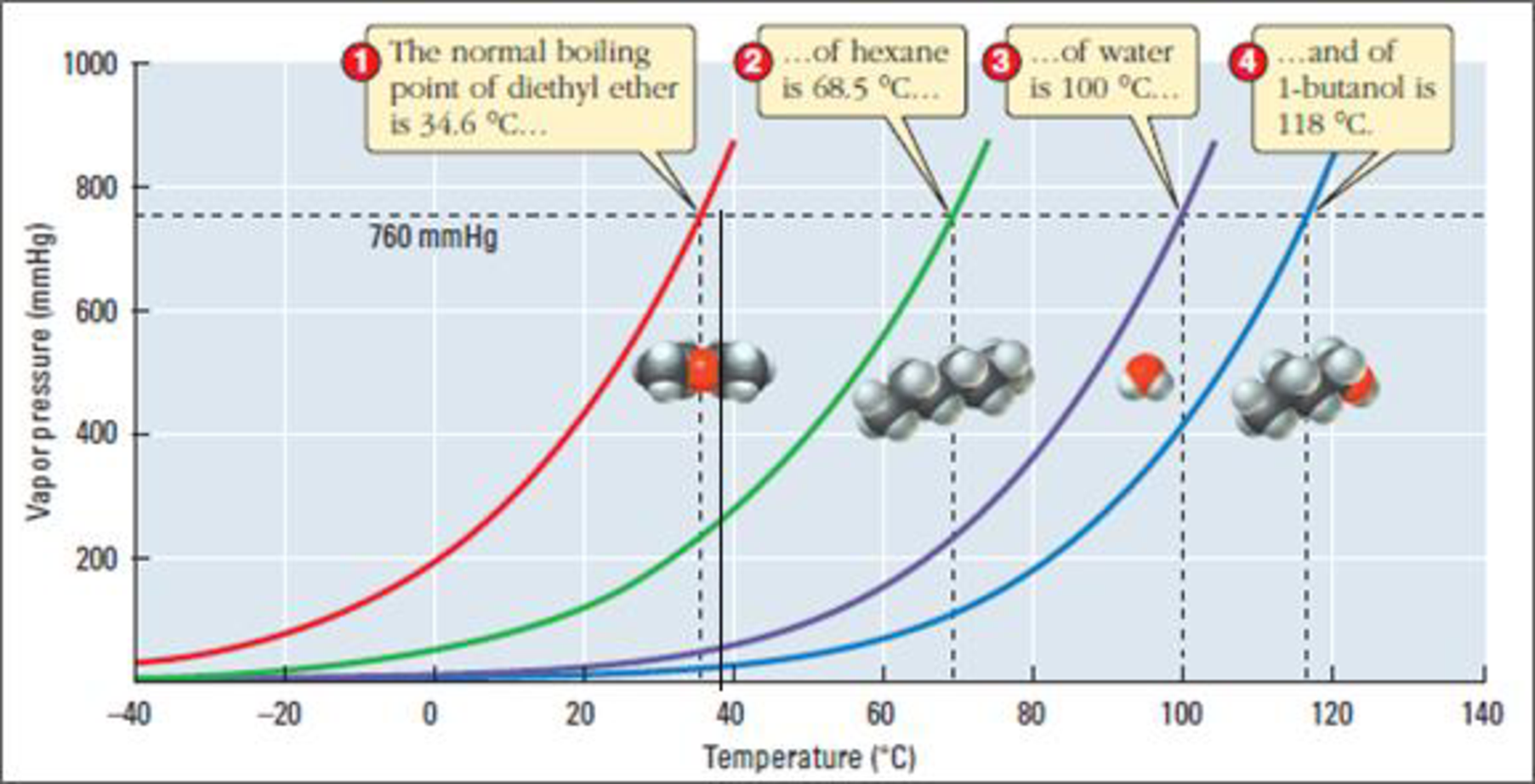
Concept explainers
(a)
Interpretation:
The reason behind less volatility of hexane than diethyl ether has to be described.
(a)
Explanation of Solution

Figure 1
Vapour pressure of a liquid is defined as the pressure of the vapour when liquid and vapour are in dynamic equilibrium. It increases with increase in temperature and a liquid with stronger intermolecular force of attractions has a lower vapour pressure at a given temperature.
If a liquid is less volatile, then it must have a lower vapour pressure which can be accounted for its stronger intermolecular force of attraction. Examining the above figure, it can be concluded that hexane has a lower vapour pressure than diethyl ether at any temperature. The non-covalent intermolecular forces of attraction acting between the molecules of hexane is London forces while in diethyl ether they are dipole-dipole forces and London forces. Because liquid hexane has a lower vapour pressure, it can be predicted that the larger hexane molecules experience larger collective intermolecular London forces than diethyl ether.
So due to this reason, hexane is less volatile than diethyl ether.
(b)
Interpretation:
The temperature at which 1- butanol have a pressure of
(b)
Answer to Problem ISP
The temperature of 1-butanol at
Explanation of Solution

Figure 2
Examine the above figure carefully. Draw a horizontal line from
(c)
Interpretation:
The reason why the boiling point of 1-butanol is greater than that of water has to be described.
(c)
Explanation of Solution
The liquid having greater boiling point means it has stronger collective intermolecular forces. Both water and 1-butanol can experience hydrogen bonding interactions. Water is a small molecule with a total of
(c)
Interpretation:
The substance which would evaporate immediately and which would remain as liquid has to be determined.
(c)
Explanation of Solution

Figure 3
The boiling point of diethyl ether is
(d)
Interpretation:
The
Concept Introduction:
Clausius-Clapeyron equation:
Where,
P1 and P2 are two sets of pressures and T1 and T2 are two sets of absolute temperatures.
R is universal gas constant.
(d)
Answer to Problem ISP
The
Explanation of Solution
Given data:
The normal boiling point of 1-butanol is
Clausius-Clapeyron equation:
Substituting all the data in the above equation and solving for
Therefore, the
Want to see more full solutions like this?
Chapter 9 Solutions
Chemistry: The Molecular Science
- A solution of benzoic acid in benzene has a freezing point of 3.1 C and a boiling point of 82.6 C. (The freezing point of pure benzene is 5.50 C, and its boiling point is 80.1 C) The structure of benzoic acid is Benzoic acid, C6H5CO2H What can you conclude about the state of the benzoic acid molecules at the two different temperatures? Recall the discussion of hydrogen bonding in Section 11.3.arrow_forwardDiethyl ether (CH3CH2OCH2CH3) was one of the first chemicals used as an anesthetic. At 34.6C, diethyl ether has a vapor pressure of 760. torr, and at 17.9C, it has a vapor pressure of 400. torr. What is the H of vaporization for diethyl ether?arrow_forwardThe vapor pressure of ethanol, C2H5OH, at 50.0 C is 233 mmHg, and its normal boiling point at 1 atm is 78.3 C. Calculate the vapH of ethanol.arrow_forward
- Use Figure 11.7 to estimate the boiling point of diethyl ether, (C2H5)2O, under an external pressure of 470 mmHg.arrow_forwardChloroform, CHCl3, has a normal boiling point of 61C. Its vapor pressure at 43C is 0.526 atm. What is the concentration (in g/L) of CHCl3 when it saturates the air at 27C?arrow_forwardWhy do liquids have a vapor pressure? Do all liquids have vapor pressures? Explain. Do solids exhibit vapor pressure? Explain. How does vapor pressure change with changing temperature? Explain.arrow_forward
 Chemistry: The Molecular ScienceChemistryISBN:9781285199047Author:John W. Moore, Conrad L. StanitskiPublisher:Cengage Learning
Chemistry: The Molecular ScienceChemistryISBN:9781285199047Author:John W. Moore, Conrad L. StanitskiPublisher:Cengage Learning Chemistry & Chemical ReactivityChemistryISBN:9781133949640Author:John C. Kotz, Paul M. Treichel, John Townsend, David TreichelPublisher:Cengage Learning
Chemistry & Chemical ReactivityChemistryISBN:9781133949640Author:John C. Kotz, Paul M. Treichel, John Townsend, David TreichelPublisher:Cengage Learning Chemistry & Chemical ReactivityChemistryISBN:9781337399074Author:John C. Kotz, Paul M. Treichel, John Townsend, David TreichelPublisher:Cengage Learning
Chemistry & Chemical ReactivityChemistryISBN:9781337399074Author:John C. Kotz, Paul M. Treichel, John Townsend, David TreichelPublisher:Cengage Learning
 Chemistry: An Atoms First ApproachChemistryISBN:9781305079243Author:Steven S. Zumdahl, Susan A. ZumdahlPublisher:Cengage Learning
Chemistry: An Atoms First ApproachChemistryISBN:9781305079243Author:Steven S. Zumdahl, Susan A. ZumdahlPublisher:Cengage Learning ChemistryChemistryISBN:9781305957404Author:Steven S. Zumdahl, Susan A. Zumdahl, Donald J. DeCostePublisher:Cengage Learning
ChemistryChemistryISBN:9781305957404Author:Steven S. Zumdahl, Susan A. Zumdahl, Donald J. DeCostePublisher:Cengage Learning





